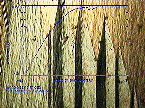
The data presented here is discussed in detail in the paper: ``Orientation Dependence of the Pseudoelastic Response of Cu-Al-Ni in Tension,'' which appeared in The Journal of the Mechanics and Physics of Solids, 43(6), 1995, pp. 869-895. The abstract of this paper is given here
Each of the microstructures that form consist of several Austenite (cubic - high temperature)- Martensite (orthorhombic-low temperature) interfaces. The martensite side of interface has a twinned structure which is necessary for kinematic compatility across the A-M interface. An image of an A-M interface is here, which was scanned from a picture taken by Dr. C. Chu. In this image the solid maroon color on the left is austenite and the laminated maroon-green structure is the twinned martensite. The base of the image is 370 microns wide. The twinned martensite structure is too fine to see in any of the other microstructure images here.
Here are some images of the microstructures observed. The tension axis is vertical and images taken under load have superimposed load-displacement curves.
This plot compares the stress-strain curves for these three specimens.
The following three items are movies of the formation of the
microstructures in the images above. There are SGI movie format versions of
these MPEG movies available by clicking the
![]()
 (760K)
(760K)
 (528K)
(528K)
 (701K)
(701K)
 Here is a visualization of
the 3-D transformation surface in this material. The distance from the center
is the tensile transformation stress in that direction. The maximum stress is
needed in the [111] directions (14K).
Here is a visualization of
the 3-D transformation surface in this material. The distance from the center
is the tensile transformation stress in that direction. The maximum stress is
needed in the [111] directions (14K).
The 96 solutions to the Crystallographic Theory of Martensite problem for Cu-Al-Ni that give the A-M interface orientations are listed here. See Shape-Memory publication 6 (list on my main page) for more details.